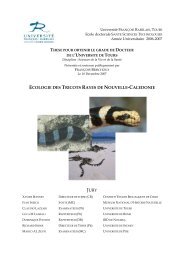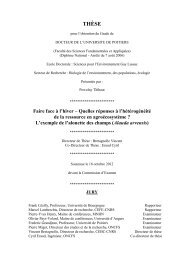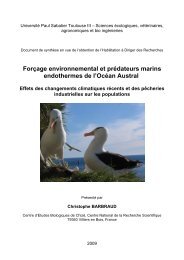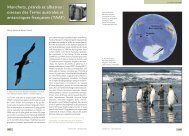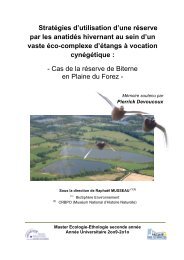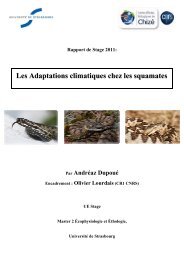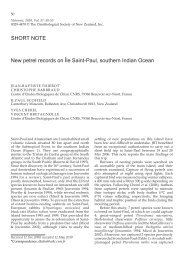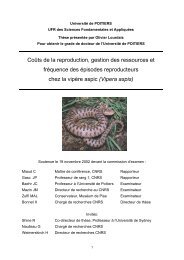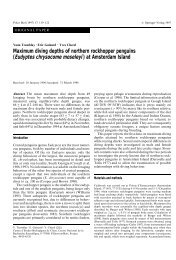Fourth International Orca Symposium and Workshop - CEBC - CNRS
Fourth International Orca Symposium and Workshop - CEBC - CNRS
Fourth International Orca Symposium and Workshop - CEBC - CNRS
Create successful ePaper yourself
Turn your PDF publications into a flip-book with our unique Google optimized e-Paper software.
− film produces the highest-resolution images <strong>and</strong> is recommended over digital<br />
photography (although with technical improvements digital will likely take over as the<br />
medium of choice in the future)<br />
− images from video stills are almost worthless for killer whale photo-identification<br />
− when the film is analysed, it is recommended that every identifiable individual in<br />
every image be entered in a long-term database<br />
In British Columbia, identification photographs have been extremely useful for analyses<br />
of association patterns. In these analyses the frequency with which any two individuals are<br />
either identified together in the same image or appear in consecutive images is used to<br />
calculate an objective index of the strength of their social affiliation. A general discussion of<br />
the application of photo-identification to association analysis ensued. van Ginneken<br />
questioned the utility of association indices based on the number of photographic events,<br />
rather than the total time spent together. Olesiuk agreed, <strong>and</strong> noted that if the study were<br />
starting again, he would want to see proximity <strong>and</strong> time spent together measured, rather than<br />
simple presence in the same encounter/ consecutive image. He said that the method worked<br />
well in the BC study largely because of the enormous database: more than 50,000 frames—it<br />
would not work as well in smaller studies. Barrett-Lennard pointed out that in the first 15<br />
years of research in BC, researchers attempted to photograph groups of killer whales in single<br />
images, but in recent years there has been more emphasis on full-frame photographs as<br />
individuals--making association analysis by this method more difficult. According to the<br />
methods used to date, this will indicate a weakening of the strength of association for many<br />
pairs. Olesiuk agreed <strong>and</strong> noted that field researchers would do well to identify photographic<br />
sampling criteria <strong>and</strong> stick to them. Several researchers noted that 1) regardless of the criteria<br />
used regarding the number of whales per image, it is best to work systematically through<br />
each group of killer whales in every encounter <strong>and</strong> 2) although the models established in the<br />
early British Columbia studies are general helpful, researchers should establish photographic<br />
sampling protocols based on the objectives of their own studies.<br />
In addition to association analysis, identification photographs are used to estimate<br />
abundance. A discovery curve is a useful way of generating a rough abundance estimate. In<br />
this approach, one simply plots the total number of identified whales that have been<br />
catalogued in each year of an study. When the total number of identified whales levels off<br />
despite ongoing photo-identification work, it is assumed that most of the individuals in the<br />
population have been identified. A second approach is sight / re-sight analysis. Here, a<br />
researcher photographs as many whales as possible in the study area over a defined sighting<br />
period. At a later point, he or she repeats the exercise, <strong>and</strong> then analyses the photographs to<br />
determine how many of the individuals were sighted twice. In the method’s simplest form,<br />
the ratio of the number sighted twice to the total number sighted is assumed to be equal to the<br />
ratio of the total number sighted to the total population. Many sophisticated variants of this<br />
basic relationship are described in the literature. Care must be taken when using photoidentification<br />
data in sight / re-sight analysis because abundance estimates are strongly<br />
influenced by photo-quality <strong>and</strong> animal distinctiveness. A powerful way of eliminating the<br />
bias is to split the process into three stages: one observer or group of observers scores photoquality,<br />
another scores animal distinctiveness, <strong>and</strong> the most experienced observer scores<br />
matches between samples.<br />
Acoustic Analysis<br />
John Ford’s study of killer whale calls in late 1980’s <strong>and</strong> early 1990’s showed that<br />
British Columbian killer whales use group-specific call repertoires. Furthermore, he showed<br />
FOURTH INTERNATIONAL ORCA SYMPOSIUM AND WORKSHOPS<br />
SEPTEMBER 23-28 2002, <strong>CEBC</strong>-<strong>CNRS</strong>, France<br />
26



